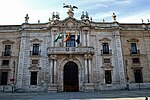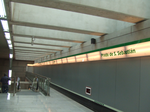University of Seville
1505 establishments in SpainBuildings and structures in SevilleEducation in SevilleEducational institutions established in the 1500sEngineering universities and colleges in Spain ... and 2 more
Universities in AndalusiaUniversity of Seville

The University of Seville (Universidad de Sevilla) is a university in Seville, Spain. Founded under the name of Colegio Santa María de Jesús in 1505, it has a present student body of over 65,000, and is one of the top-ranked universities in the country.
Excerpt from the Wikipedia article University of Seville (License: CC BY-SA 3.0, Authors, Images).University of Seville
Calle San Fernando, Seville Casco Antiguo
Geographical coordinates (GPS) Address Nearby Places Show on map
Geographical coordinates (GPS)
| Latitude | Longitude |
|---|---|
| N 37.3807579 ° | E -5.9912307 ° |
Address
Universidad de Sevilla - Rectorado (Real Fábrica de Tabacos)
Calle San Fernando
41004 Seville, Casco Antiguo
Andalusia, Spain
Open on Google Maps











